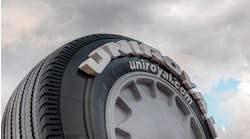When tire labeling legislation came into force around two years ago in Europe, it was viewed by many people in the industry as a signal to move forward and make future tires as “green” and fuel efficient as possible.
It would be fair to say that the concept of tire labeling in Europe has received a “mixed bag” of approval and disapproval, but as time goes by more and more tire industry members are appreciating the long-term significance of this ground-breaking development in the industry.
Looking at the facts for a moment, the green tire market is confidentially expected to increase at a compound annual growth rate of 9.82% up to 2016, and this forecast is supported by a general tightening of fuel economy standards and a growing demand for tires that are increasingly environmentally friendly from many countries around the world including Brazil, Russia, India, China and South Africa.
Worldwide growth
The ever-growing worldwide green tire market accounted for around 28% of total tire market sales in 2012, and in three years’ time (2017) it can be expected to reach a 35% market share.
In Europe, green tires are sometimes described as “energy tires” where the main advantage of going green is promoted as lower rolling resistance. They are therefore viewed to be an important growth market in terms of business to all European tire-related companies.
As with all innovative developments in business, there is an ongoing series of reports and studies shadowing their success. One recent study on green tires and mobility that specifically caught my attention was published in Germany by the Technical University in Munich which makes a number of significant revelations.
One such was as tires are a product specially suitable for reducing CO2 emissions by 4.7kg (automatic transmission vehicles - 3.1kg), all drivers are able to make their own contribution to helping the global environment. The report also mentions that fitting green tires to a vehicle has the potential to increase mileage performance by as much as 40% and also extend vehicle servicing intervals.
Green ingredients
At the same time I have noticed that tire manufacturers (many of whom are based in Europe) are also playing an important role in this green tire revolution by trying to source alternative products to implement into the mixing process when producing energy-efficient tires for the future.
For example, Continental is currently researching the interesting option of using dandelion flower oil as a future ingredient in their production process. At the same time I am aware that Goodyear is also endeavoring to incorporate soybean oil nto its manufacturing process.
It seems the idea of using soybean oil is a very appealing prospect as it would effectively reduce the amount of petroleum-based oil required when manufacturing tires and increase tread life by around 10%. Goodyear confirms that soybean oil blends efficiently with the silica used in the process and also reduces factory energy consumption. The combination also has the potential to decrease the amount of oil used by a staggering seven million gallons a year while also improving mixing capabilities. It is also very significant to mention that within present-day rolling resistance technique terms.
Alongside Japan, Europe is at the most advanced level in this important technology process and more advanced than Asia or the United States. So on the face of it, Europe has everything in place to be considered a market-leading continent in the green tire industry.
However, as with many potential success stories there is always a black cloud of doubt on the horizon. In this case it is the continuing financial uncertainty (some would say crisis) concerning the future stability of the Euro currency which has, to a certain degree, decreased the overall sales performance in cars in many European countries which in turn has affected the future growth of the green tire industry.
Having said that, I am a firm believer that positive technology will always find a way around economic hurdles, so I am sure that in Europe and on a global basis, green tire technology will increase its popularity in due course. ■
John Stone has been working within the global tire industry for the past 20 years. In 2004 he launched his own company, Sapphire Media Services, as a business media consultant with clients around the globe. Stone also writes for tire and automotive-related publications in Europe, South Africa and Asia.
For more articles by John Stone, see:



